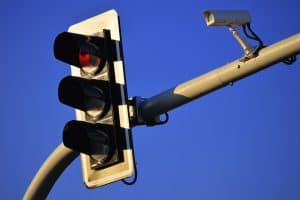 If you’ve passed a driver’s test and currently drive a vehicle (or even ride a bike), you know that a yellow light means “slow down.” But – let’s be honest – we’ve probably all pushed a little harder on the gas once or twice when that light turns amber to avoid getting stuck sitting at a red light. We know it’s not the safest move, but sometimes we do it anyway.
If you’ve passed a driver’s test and currently drive a vehicle (or even ride a bike), you know that a yellow light means “slow down.” But – let’s be honest – we’ve probably all pushed a little harder on the gas once or twice when that light turns amber to avoid getting stuck sitting at a red light. We know it’s not the safest move, but sometimes we do it anyway.
However, every so often, a driver speeds up and tries to beat that red light and causes a terrible car accident. This is the worst that might happen when someone fails to beat a red light. The best that might happen is that driver doesn’t hurt anyone, but gets a ticket from a red light camera.
Red light cameras came into usage in the United States around the 1990s and, over the years, became a point of contention between citizens and local government. Advocates of using red light cameras positioned them as a means of safety – to reduce accidents; those against red light cameras accused local government of using the cameras as a means to easily collect revenue for the town.
This criticism was sometimes well-founded. In 2014, the city of Chicago paired their red light camera system with the shortest allowable yellow light system. This indeed created a great deal of traffic violations and revenue, but it also created an increase in rear-end collisions from motorists trying to avoid the cameras.
Do red light cameras reduce accidents?
According to a report from the Insurance Institute for Highway Safety (IIHS), fatalities caused by drivers ignoring red lights increased 17 percent between 2012 and 2016 (the most current data available). In 2016 alone, more than 800 people were killed in crashes involving drivers who ran red lights. The IIHS also reports that more than half of these fatalities were people in the other vehicle, cyclists, and pedestrians.
Red light cameras have been met with much criticism over the years. However you feel about them, the important question is, “Do red light cameras work?” And, working in partnership with AAA and Advocates for Highway and Auto Safety, IIHS says the answer is yes. Their research showed that the introduction of red light cameras reduced traffic violations by about 40 percent. When they compared car accident data between cities with red light cameras and those without, they found cities with cameras had a reduction in red-light-running deaths of 21 percent.
“Red-light cameras can play a role in improving traffic safety for all road users and should be placed where they can benefit a community, like at intersections with high numbers of fatalities,” said Jill Ingrassia, managing director of Government Relations and Traffic Safety Advocacy for AAA. “When properly implemented, red-light cameras can help save lives and can serve to supplement law enforcement efforts, rather than generate revenue for governments.”
Even so, the number of cities and towns with red light cameras has been on the decline since 2012. The IIHS reports that, in July 2018, there were 421 communities across the United States. In 2012, there were 533, and, as noted earlier, there’s been a 17 percent increase in red light accidents since then.
Car accidents at red lights can be devastating. Careless drivers can cause serious accidents and severe trauma. If you were injured because someone ran a red light, talk to the Nashville car accident attorneys at the Rocky McElhaney Law Firm. We’ll stand up for your rights and seek compensation for your losses. Call our lawyers today at 615-246-5549 or use our contact form to schedule an appointment. We have offices in Nashville, Hendersonville, and Knoxville.
